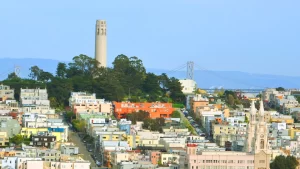CALL US! 1-415-766-2722
Fun@SanFranciscoJeepTours.com
Coit Tower is named after Lillie Hitchcock Coit, a wealthy socialite who had a soft spot for local firefighters. When she passed, she left a third of her fortune (which is almost 2 million dollars today!) to the city with instructions that it was to be used to add beauty to the city she loved.
Coit Tower is sometimes referred to as the “Coit Memorial Tower” in honor of the volunteer firemen who lost their lives during the 5 great fires in San Francisco. Although some say it looks like a fire hose nozzle, it was not designed to look like one.

The same architectural firm that built San Francisco City Hall also designed Coit Tower, but the architect behind the design was Henry Howard, not Arthur J. Brown.
The tower’s vertical design was chosen to make a monumental statement within the small site and budget while complementing the proportions of the hill. And that fluted look? That’s to avoid looking top-heavy. The difference in diameter at the top of the tower compared to the bottom is just 18 inches.
 See San Francisco Up Close – Private Jeep Tours!
See San Francisco Up Close – Private Jeep Tours!Explore San Francisco’s top attractions with a private guide, enjoy a thrilling Golden Gate Bridge drive, and stop at the best scenic spots.
Spots fill fast—Book your Jeep adventure today!
The interior murals were created as part of the Public Works of Art Project during the Depression era, employing out-of-work artists. They were considered incendiary at the time for their socialist overtones, but also for daring to depict people of color alongside white workers.
During the longshoreman’s strike of 1934, the city painted over some of the more offending elements for fear that the art would stir up too much sympathy for workers. They also locked the public out of the tower to keep the murals from public view for a while.
There are 27 murals in total, created by 26 artists; four of which were women. The total cost of the mural project: $26,022 and was completed on budget.
Shortly after the tower opened, the owner of a Union Street cafe went up to the roof to fire a rifle at it, complaining that it “invaded the sanctity of his view.”
As you wander the trails that wind around the tower, you may hear the raucous chatter of the neighborhood’s most famous (and noisiest) residents, the flock of parrots featured in the 2005 film “The Wild Parrots of Telegraph Hill”.
